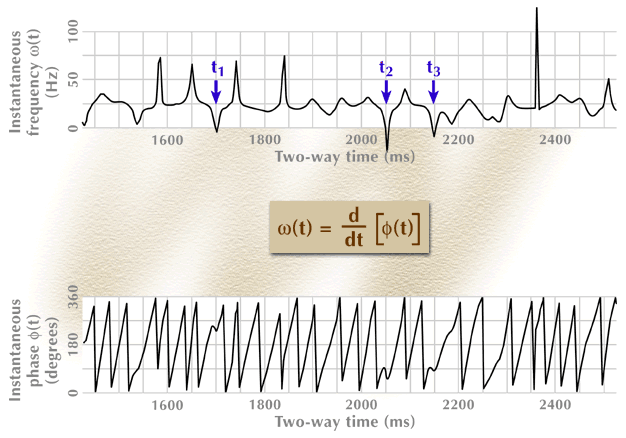

Instantaneous Frequency
The instantaneous frequencies calculated for the seismic trace discussed in Figure 5 are shown in the top panel of Figure 6.

Figure 6. The instantaneous-frequency seismic attribute function. The calculated frequency values at times t1, t2, t3 are physically impossible because they are negative. Other modules will show that these anomalous frequency behaviors are some of the most useful seismic attributes that an interpreter can use. Note that the reflection waveform at times t1, t2, and t3 is slightly distorted (Fig. 2) because of the destructive interference of two or more overlapping wavelets, demonstrating that anomalous frequencies typically coincide with, and highlight, distorted wavelets such as are produced at structural and stratigraphic discontinuities.
The animation sequence starts with the input data for the process (bottom), proceeds through an action step (center box), and then produces the required output function (top). Only three data points are processed through the action-step box.
The phase function calculated previously (Fig. 5) is repeated as the bottom trace of Figure 6. Although negative frequencies cannot exist physically, this instantaneous-frequency function exhibits negative values at time positions t1, t2, and t3. Comparing the time coordinates of these anomalous frequency values with the time coordinates of the instantaneous-phase function shows that rather than exhibiting its typical, monotonically increasing behavior in these time intervals, the phase momentarily decreases in magnitude at time samples t1, t2, and t3, causing the time rate of change of phase (or the slope of the phase function), which is the instantaneous frequency, to be negative. Although negative frequencies are physically impossible, data examples in subsequent modules will demonstrate that these anomalous frequencies should always be preserved because, when they are displayed in an eye-catching color, they serve to shift an interpreter's attention quickly to subtle, anomalous phase changes that are often associated with structural and stratigraphic discontinuities.
 |
 |
| ©1999 AGI |